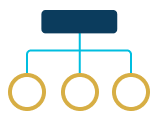The Implementation for Family and Self-Advocates

From initial conversations to exploring individual technology support options, the team (providers, families, self advocates, and case managers) has worked diligently and thoughtfully to build a plan that focuses on the needs and wishes of the individual supported—both their safety and security as well as desired lifestyle goals.
Now that the technology supports have been assessed and agreed upon, it is time to physically put the solutions in place and move forward with their utilization.
The degree of involvement in the implementation phase for families/self-advocates will depend on where the technology will be used. If supports are utilized in a location controlled by a service provider, involvement will be substantially less than if the technology is used in a person’s own home or in the home of a family member.
Install
As installation occurs, whether over the course of a few hours or days, families and self-advocates should pay close attention as the technology supports are being set up in the home. Asking questions, expressing any remaining concerns, and communicating needs will help the installation process go smoothly and ensure families/self-advocates are aware of the location of all supports in place.
Training
Once setup has occurred, training can begin to ensure families and self-advocates understand how the technology is being used and what actions need to be taken on a day-to-day basis or in an emergency situation.
During training, families and self-advocates should:
- Ask questions to ensure you are fully aware of how the technology works, what each piece of equipment is for, and how everything works individually or together.
- Get hands-on experience with the equipment as needed.
- Express any final concerns or uncertainties as response plans and security protocols are reviewed and put in place.
- Discuss the timeline for implementation and when it will be reviewed to see what has been learned and what changes or adaptations would be helpful.
Sometimes implementing the use of technology coincides with other changes in the service and support plan. This could include a move to a new home or a change in staff schedules and/or routines. The training phase is a good time to review those changes and the plan for implementing them.
Go Live
Whether going live means phasing in technology supports or “flipping the switch” on all supports at once, it is important to realize that things might not all work perfectly at first—there will be an adjustment period and a learning curve as everyone gets used to the new processes.
Trusting technology to do something that a person has done in the past is an adjustment, and it is important to remember that there are individuals on the other end of the technology to help if needed. Backups as well as fail safes are also in place to ensure the safety and security of the individual. Make sure a care profile is available so answers may be obtained when needed.
Testing/Revisions
Following the go-live phase, the team will continue to test and revise the technology support options as needed to fit the individual’s safety concerns and lifestyle goals.
Not every scenario can be planned for in advance, but through the testing phase, the team will learn more about the individual’s living style and be able to adapt the technology and response plans as needed. As an example, a group of men who had just implemented technology supports in their home got hungry late one night and ordered a pizza. As they opened the door for the delivery person, a response plan was triggered. Why? Because their front door sensor showed the door opening when the men were typically sleeping. As habits are formed, and as individuals adjust to the new supports in place, scenarios like these will lessen dramatically.
Alternatively, this adjustment period may also bring to light habits that were not known prior to implementation. Utilizing technology has the benefit of tracking patterns in behaviors or habits that might uncover an underlying issue or an opportunity for increased self-sufficiency. During testing, it might be found that some equipment is not helpful or not needed and some items might be either added or taken away as the supports mold to the individual’s lifestyle.
Next Steps
If you have additional question about Implementation, ask one of our Mentors.
Then, review progress and determine if goals have been met.




